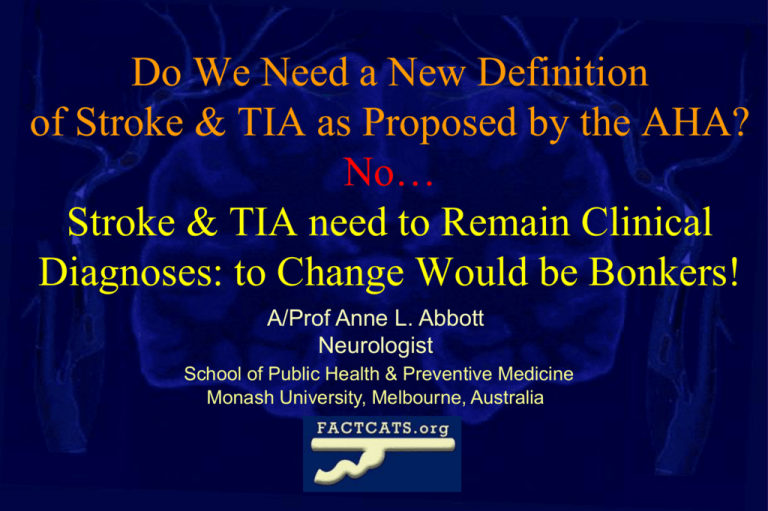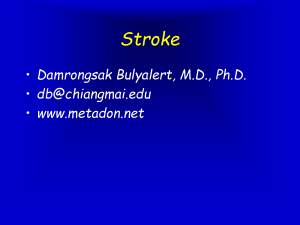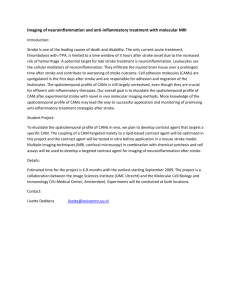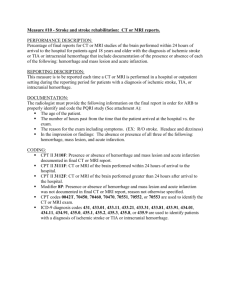Do We Need a New Definition of Stroke & TIA as Proposed by the
advertisement

Do We Need a New Definition of Stroke & TIA as Proposed by the AHA? No… Stroke & TIA need to Remain Clinical Diagnoses: to Change Would be Bonkers! A/Prof Anne L. Abbott Neurologist School of Public Health & Preventive Medicine Monash University, Melbourne, Australia Disclosures My academic work has been funded only by independent grants & family subsidies This presentation is proudly supported by the Bupa Health Foundation Current Main Stream Definitions Stroke: • Is ‘the rapidly developed clinical signs of focal (or global-SAH) disturbance of cerebral function lasting >24 hours or leading to death with no apparent cause other than of vascular origin’. (WHO, 1980) • Sub-classified using brain/vascular imaging etc. • Can be confirmed by pathology. TIA (‘mini-stroke’): • ‘Episodes of temporary & focal cerebral dysfunction of vascular origin, rapid in onset which commonly last 2-15 minutes but occasionally up to a day. Resolution is swift & leaves no permanent neurologic deficit’. (Ad hoc Committee, 1975) Perceived Limitation A 24 - hour differentiation has the potential to delay effective hyper-acute stroke therapies. For example: ED physicians say ‘why are you thrombolysing the patient so quickly - how do you know it's not just a TIA?’ Proposed New Definitions of Stroke & TIA 1. Easton et al, Stroke, 2009 2. Sacco et al, Stroke, 2013 Underlying ProposalStroke/TIA are imaging dependent & may be defined according to MR or CT brain imaging alone, independent of clinical features: - type - severity & - duration a neurologic deficit 1. Definitions are Inconsistent, Open to Interpretation & De-Standardising (Confusing) Proposed Definition of TIA 2009 – ‘A transient [not defined] episode of neurological dysfunction caused by focal brain, spinal or retinal ischaemia without [imaging evidence of] acute [not defined] infarction [not defined].’ 2009 – or ‘Symptomatic ischaemia [focal/global] with no [imaging] evidence of infarction [acute or chronic, focal/global]. 2013 –Not given but the 2009 ‘definition’ was endorsed. Ischaemic Stroke 2009 - [Imaging evidence of] Infarction of central nervous system tissue [focal or global]. Later - Can be symptomatic or silent… Later - Can be diagnosed on just clinical features such as prolonged deficits lasting days. 2013 - An episode of neurological dysfunction [symptomatic] caused by focal cerebral or spinal or retinal infarction. ‘Stroke’ Sacco et al, AHA/ASA, Stroke, 2013 A table of >10 scenarios using 405 words is given. The term “stroke” should be broadly used to include all of the following: Definition of CNS infarction: CNS infarction is brain, spinal cord, or retinal cell death attributable to ischemia, based on 1. pathological, imaging, or other objective evidence of cerebral, spinal cord, or retinal focal ischemic injury in a defined vascular distribution; or 2. clinical evidence of cerebral, spinal cord, or retinal focal ischemic injury based on symptoms persisting•24 hours or until death, and other etiologies excluded. (Note: CNS infarction includes hemorrhagic infarctions, types I and II; see “Hemorrhagic Infarction.”) Definition of ischemic stroke: An episode of neurological dysfunction caused by focal cerebral, spinal, or retinal infarction. (Note: Evidence of CNS infarction is defined above.) Definition of silent CNS infarction: Imaging or neuropathological evidence of CNS infarction, without a history of acute neurological dysfunction attributable to the lesion. Definition of intracerebral hemorrhage: A focal collection of blood within the brain parenchyma or ventricular system that is not caused by trauma. (Note: Intracerebral hemorrhage includes parenchymal hemorrhages after CNS infarction, types I and II—see “Hemorrhagic Infarction.”) Definition of stroke caused by intracerebral hemorrhage: Rapidly developing clinical signs of neurological dysfunction attributable to a focal collection of blood within the brain parenchyma or ventricular system that is not caused by trauma. Definition of silent cerebral hemorrhage: A focal collection products within the brain parenchyma, subarachnoid space, or ventricular system on neuroimaging or neuropathological examination that is not caused by trauma and without a history of acute neurological dysfunction attributable to the lesion. Definition of subarachnoid hemorrhage: Bleeding into the subarachnoid space (the space between the arachnoid membrane and the pia mater ofthe brain or spinal cord). Definition of stroke caused by subarachnoid hemorrhage: Rapidly developing signs of neurological dysfunction and/or headache because of bleeding into the subarachnoid space (the space between the arachnoid membrane and the pia mater of the brain or spinal cord), which is not caused by trauma. Definition of stroke caused by cerebral venous thrombosis: Infarction or hemorrhage in the brain, spinal cord, or retina because of thrombosis of a cerebral venous structure. Symptoms or signs caused by reversible edema without infarction or hemorrhage do not qualify as stroke. Definition of stroke, not otherwise specified: An episode of acute neurological dysfunction presumed to be caused by ischemia or hemorrhage, persisting•24 hours or until death, but without sufficient evidence to be classified as one of the above. Too long & not compatible with 2009 ‘Infarction’ 2009 - Not actually defined but implied as diagnosed by brain imaging. Pathologist no longer has a role 2013 - Cell death due to ischaemia diagnosed by pathology, imaging or >24hr clinical deficit. Clinician or radiologist can replace the pathologist. 2. Definitions are Scientifically Flawed Brain Imaging is Very Useful But Not all Powerful • • MRI more sensitive than CT in hyperacute ischaemia MRI-DWI has imperfect – sensitivity for ischaemia in stroke patients (47- 100%) – specificity for ischaemia in stroke patients (75-96%) – May be improved by other parameters (eg rCBF, PWI) • MRI lesions can disappear/reverse • • • Great aid to classify mechanism, prognosis, treatment Provides different info from the clinical & pathological Definitions should differentiate these strengths, not nullify (6.7% esp. reperfusion) 3. Definitions are No Longer Primarily Clinical or Duration Focused • Less widely applicable to patients (acutely/later) • Incompatible with other medical knowledge - from the past - from the present/future (esp. about preventing whole episodes of sustained neurologic deficits) • Clinical deficit matters most to patients-drives Dx, risk stratification & Rx. Imaging + pathology help. Example: Measuring Ipsilateral Stroke Rate in Asymptomatic Carotid Stenosis Outlier from Silvestrini et al. 2010. - Easton et al 2009… Average Annual Rate of Ipsilateral Stroke (Raw data,%) Updated Meta-analysis. After Abbott. Stroke, 2013 2.9 * Stroke ‘Infarction of central nervous system tissue’ TIA ‘Transient episode of neurological dysfunction caused by focal ischaemia without acute infarction.’ ??????????????? The Way Forward • Educate all - Stroke is bad because of the neurologic deficit. - Deficit duration exists over a poorly predictable time continuum. - Rx those most likely to benefit overall, even if some would resolve. - Aim: Use hyperacute stroke Rx to convert more sustained stroke deficits into transient deficits. - Use inclusive terminology for 0-24hrs (stroke/ACVS): then mini stroke vs a sustained stroke. • Maintain the primarily clinical definition & sub-classify using imaging etc. • Maintain distinct clinical vs imaging vs pathological terminology. • Still measure clinical status at baseline & at 24 hrs (somewhat arbitrary but practical, clinically relevant & highly standardising in research & practice). References i. Aho et al: Bulletin of WHO, 1980;59:113-130 ii. Ad Hoc Committee (Anonymous), Stroke 1975;6:564-616 iii. Barber et al Stroke 1999;30:2059-2065 iv. Campbell et l, JCBFM;2011:1-7 v. Easton et al, Stroke; 2009:40:2276-2293 vi. Sacco et al, Stroke, 2013;44:2064-2089 vii. Schafer et al, AJNR 2002;23:1785-1794 & 2003;24:436-443 viii. Schellinger et al 2010:75:177-185 ix. Simonsen et al, Stroke; 2015:46:00-00 x. Tehrani et al Neurology 2014;83:169-173 Acknowledgments i. Dr Silvestrini, Italy. ii. Dr Anthony Kam, Consultant Radiologist, Alfred Hospital, Melbourne. Definition of Definition ‘The meaning of a word using other terms’ Wikipedia Best definitions will be short, accurate, consistent, easily & consistently understood by all & have purpose The Proposed Definitions Cause Unnecessary Problems Without Solving Anything








